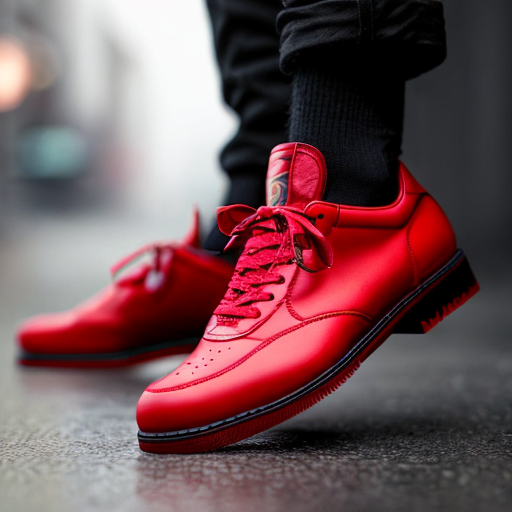The Symbolism of Red Shoes: Unveiling Their Mystique
Picture this: a pair of vibrant red shoes, standing out in a sea of black and brown footwear. What do they mean? What secrets do they hold? The symbolism of red shoes is a topic that has intrigued fashion enthusiasts and curious minds alike. Some say that red shoes represent power and confidence, as if the wearer is boldly declaring, ‘I am here, and I demand attention!’ Others believe that these crimson wonders embody passion and sensuality, igniting a fiery spark in the hearts of those who dare to slip them on. Whether you see them as a symbol of empowerment or a whimsical fashion statement, one thing is for certain: red shoes have an undeniable mystique that continues to captivate and bewitch us all.
Red Shoes Through History: From Royalty to Rebellion
Red shoes have been historically associated with power, wealth, and status. In ancient times, red dye was expensive and difficult to produce, making red shoes a symbol of luxury and privilege. In fact, during the reign of King Louis XIV of France, only members of the royal court were allowed to wear red shoes. Today, red shoes continue to hold a symbolic meaning, often representing confidence, boldness, and a touch of rebelliousness. They can be seen as a statement piece, adding a vibrant pop of color to any outfit while exuding a sense of individuality and flair.
Throughout history, red shoes have played a fascinating role in the world of fashion and beyond. In ancient times, they were a symbol of wealth and status, worn exclusively by royalty and nobility. These scarlet treasures adorned the feet of kings and queens, signifying their elevated position in society. However, as time went on, red shoes took on a new meaning. During times of rebellion and revolution, they became a powerful statement of defiance and individuality. From the red shoes worn by Dorothy in ‘The Wizard of Oz’ to the iconic red-soled heels of Christian Louboutin, these bold and daring footwear choices have become a symbol of rebellion against conformity and a celebration of personal style. Whether worn by a monarch or a rebel, red shoes continue to make a statement, reminding us that sometimes, it’s okay to stand out from the crowd and embrace our own unique path.
Red Shoes in Literature and Film: Unraveling Their Narrative Significance

Red shoes have long held a special place in the realms of literature and film, their narrative significance weaving tales of desire, transformation, and even danger. One of the most iconic examples is found in Hans Christian Andersen’s fairy tale, ‘The Red Shoes.’ In this haunting story, a young girl named Karen is bewitched by a pair of red shoes that compel her to dance uncontrollably. The shoes symbolize Karen’s desire for worldly pleasures and her inability to resist temptation. As the story unfolds, the red shoes become a metaphor for the consequences of succumbing to one’s desires, ultimately leading to Karen’s downfall.
In literature, red shoes often serve as a powerful symbol of transformation and self-discovery. In L. Frank Baum’s ‘The Wizard of Oz,’ Dorothy’s ruby slippers take her on a journey of self-realization and growth. The shoes represent her connection to her home and her inner strength, guiding her through the fantastical world of Oz. Similarly, in Salman Rushdie’s novel ‘The Enchantress of Florence,’ the red shoes worn by the enigmatic character Qara Köz become a symbol of her mysterious allure and her ability to captivate those around her.
In the realm of film, red shoes have left an indelible mark on the silver screen. Perhaps the most famous example is the 1948 film ‘The Red Shoes,’ directed by Michael Powell and Emeric Pressburger. The film tells the story of a young ballerina torn between her love for dance and her love for a man. The red ballet shoes she wears become a metaphor for her passion and dedication to her art, but also a symbol of the sacrifices she must make for her career. The film explores the conflict between artistic ambition and personal happiness, using the red shoes as a visual representation of this internal struggle.
In conclusion, red shoes in literature and film carry a rich narrative significance. They represent desires, temptations, transformations, and the complexities of human nature. Whether they symbolize the consequences of yielding to temptation, the journey of self-discovery, or the conflict between passion and personal fulfillment, red shoes continue to captivate audiences and unravel profound stories that resonate with our own desires and struggles.
The Psychology of Red Shoes: Exploring the Emotional Impact
A fun fact about red shoes is that they have been historically associated with power and prestige. In ancient Rome, only senators were allowed to wear red shoes as a symbol of their high status. This tradition continued in Europe during the Middle Ages, where red shoes were worn by nobility and monarchs. So, if you ever spot someone wearing red shoes, you might just be in the presence of someone with a touch of regal flair!
The psychology behind red shoes delves into the emotional impact they have on both the wearer and those who behold them. Red is a color that evokes strong emotions, such as passion, power, and confidence. When we slip on a pair of red shoes, we tap into these feelings, instantly boosting our self-assurance and making a bold statement. The vibrant hue demands attention and can even elicit feelings of desire and attraction from others. Whether it’s the wearer seeking a boost of confidence or the observer being drawn to the allure of red, the psychology of red shoes reveals the profound impact that color can have on our emotions and interactions.

